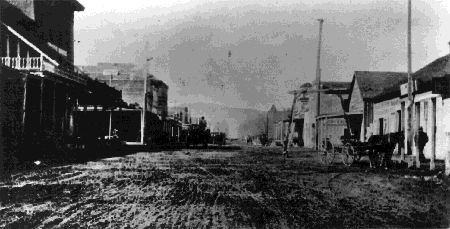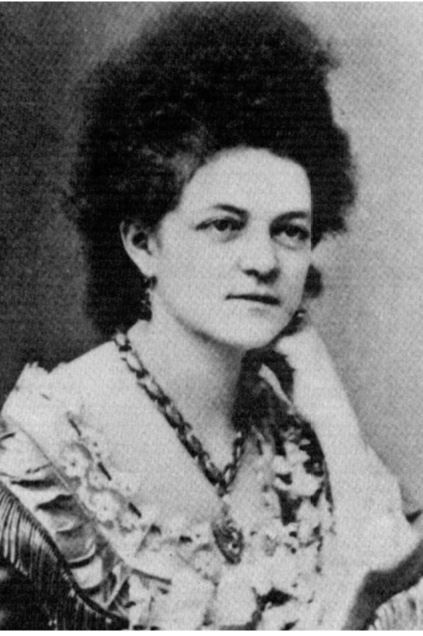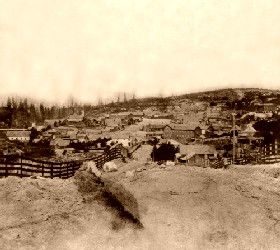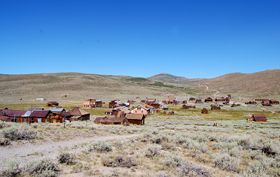Eleanore Dumont, better known as Madame Mustache, was one of the first known professional blackjack players in American history and, for over three decades, made her name famous across the mining camps of the American West.
She was thought to have been born in New Orleans, Louisiana in about 1829 but, for whatever reasons, made her way west during the California Gold Rush. Known as Simone Jules, a petite and pretty French woman in her early twenties, she arrived in San Francisco in about 1849, where she soon established herself as a gambler, favoring the game of Vingt-et-un, which means “21,” the precursor of American Blackjack.
Working at the Bella Union, she was known for her elegant dignity, aloof manner, and ability to handle stress on the card table. However, when she was suspected of card sharping, she was let go, but, not before she had obviously earned quite a bit of money.
She next made an appearance in Nevada City, California. Stepping off the stage in 1854, her bejeweled and stylish appearance created quite a stir among the rough residents of the mining camp. Two young miners quickly volunteered to carry her bags into the Fepp’s Hotel, where she registered as Eleanore Dumont.
For the next few days, she wandered up and down Broad Street, the main street of Nevada City, peering into shop windows that had gone out of business. Soon, she had the whole town talking and wondering why the young woman seemed to have nothing better to do than walk about town in her best finery.
Soon, though, the mystery would be solved after she handed a printing order to Editor Wait of the Nevada Journal for a handbill that advertised the opening of the “best gambling emporium in northern California.” Citizens all over town soon received invitations to the grand opening of the “Vingt-et-un” on Broad Street to enjoy a game with Madame Dumont as well as free champagne for all. A finely furnished and carpeted gambling den with gas chandeliers, it would only allow the entrance of well-behaved and well-groomed men, and cursing was discouraged in her presence.
Her gambling parlor opened with a bang as the men swarmed in. Having cleaned up and put on their best clothes for the occasion, they found Miss Eleanore witty, vivacious and charming as she moved around the room talking to them before beginning her game. Rolling her own cigarettes and drinking champagne, she deftly kept them at arm’s length, telling them all tactfully that she was a lady.
Though few at the time knew how to play the game of “21,” as Faro was the favored gambling endeavor, the novelty of having a pretty female dealer quickly attracted a number of players. Dealing like the seasoned pro that she was, the miners more often lost than they won; however, they seldom complained, thinking it a privilege to be in her presence. When she won, she would sweetly express regret and treat the losers to free champagne. When she lost, she seemed pleased for their good fortune.
During this time, Dumont was not known to have any lovers, kept her personal life very private, and women were prohibited from coming into her establishment or loitering outside.
She soon built up enough capital that she wanted to open a larger establishment. She took on a partner named David Tobin, a professional gambler from New York, and the two opened Dumont’s Palace, which also provided games of Faro and Chuck-a-luck. Hiring more dealers and a small band of violinists to entertain the gamblers, the Palace was also successful, keeping a dozen games going day and night.
But, for Nevada City, like so many other mining camps, the gold would finally play out, and Eleanore Dumont then made her way to Columbia, California in 1857, where she set up her table in a hotel.

Carson City Nevada in the early days. Photo from Visit Carson City.
A couple of years later, she decided to get out of the business and though she knew little of animals, she bought a ranch in Carson City, Nevada. Lonely and out of her element, that’s when she met Jack McKnight, who swept her off her feet. A handsome, well-dressed man, who was a smooth-talker who claimed to be a cattle buyer, Eleanore was instantly infatuated. However, McKnight was actually a conman who made his living swindling others. Less than a month later, he disappeared with all her money, had sold her ranch, and left her with all the outstanding debts.
Never a timid woman, legend has it that she went after the cad, tracked him down and opened up on him with a double blast from a shotgun. Suspected of the crime, she was never charged and denied responsibility. Years, later; however, she allegedly confessed to killing him.
Alone and destitute, she was forced to return to the mining camps and take up gambling again. In 1861, she went to Pioche, Nevada, where she set up her table. Here, she was said to have used her powers of charm to subdue a noisy, quarreling crowd of miners. As several drunken miners began to flourish pistols, looking for a fight, Madame Dumont quietly approached the noisiest of them, and laughingly reproved from their ungallant conduct, succeeding in quieting the entire crowd.
As the mines played out in Pioche, she would move again and over the next two decades, she would follow the gold from one camp to the next, drifting through places such as Bannack, Fort Benton and Helena, Montana; Salmon and Silver City, Idaho; Corinne, Utah; Eureka and Virginia City, Nevada; Deadwood, South Dakota; Tombstone, Arizona; and finally ending up in Bodie, California.
In the early years, Eleanore brandished her chastity in the womanless gold-rush camps and enticed men by her virtue and manners to come and play with her. However, over the years, as she aged, her body filled out to plumpness and the fine unflattering growth of hair on her upper lip darkened. With the waning of her beauty, she was no longer able to coax the roughness out of the miners. No longer did they refrain from cursing, remove their hats, and tell only clean jokes. Eleanore too would eventually take on many of these hardened characteristics. Whereas she first would drink only wine or champagne in moderation, she turned to whiskey. She too took on rougher language and easily tolerated ribald talk.
Though she gradually transformed from a polite beauty to a mining camp character, there was still magic in her name, and she continued to draw customers. Through the years; however, her establishments became more second rate and she ceased to be a novelty as more and more as women began to fill the mining camps.
In many cases rival gamblers resented her crowds and were quick to defame her character, alleging that she was a card sharp. It is unclear as to whether she ever turned to sharping, but, she obviously benefited from the dealer’s edge in blackjack. She needn’t have had to have cheated in order to win. Overall, she was a popular dealer because people believed she played an honest game and had a reputation for always paying her debts and paying out any winners fairly. In some cases, she was even known to loan a few dollars to the miners to gamble with.
Later, when she also began to act as a true “Madame,” and added prostitution to her earning capacity, she would regain some of her old charm and poise in the dual role of bordello Madame and gambler.
By the time Eleanore joined the miners in the rush to Bannack, Montana in the early 1860s, she had expanded beyond simple gambling and was also was running a brothel. It was here that she earned the moniker of “Madame Mustache” when a drunk miner impolitely called her the name. Unfortunately, the name stuck, though few were unwise enough to call her that in her presence.
Stories abounded throughout the mining camps of the savvy lady gambler, and moving with the rest of them, she, no doubt, met many of the same faces over and over again. One story tells that as she left her table with her gambling stakes, she was accosted by two robbers who demanded her purse. After calmly informing the pair that they would not take her purse, she reached under her skirt, brought out a derringer and fired point-blank at one of the men, dropping him to the ground. The other disappeared.
At times, Eleanore could be a tough, shrewd businesswoman, but she also possessed a good heart, often providing free meals and a place to stay for miners who needed it. While at Fort Benton, Montana, she was perpetuating her reputation working in what was known as “the bloodiest block in the West.” Here, on Front Street, the block contained more than a dozen saloons, dance halls, and brothels, where Eleanore had set up her table in a gambling den called “The Jungle.” In June 1867, as she sat at her table dealing cards, she spied an incoming steamboat called the Walter B. Dance coming into to dock. Having heard a report that the boat was carrying smallpox aboard, she jumped up from her table, ran down the stairs and across the street to the levee, where she brandished two pistols, warning the captain not to stop.
When the rush was on in Deadwood, South Dakota, she was also present. While there, some say that she was friends with Calamity Jane and tried to teach her the finer points of poker. However, if this is true, her attempts failed, as Jane was always known to be a poor gambler. In 1877, a Deadwood reporter would say of her: “A character who attracts the attention of all strangers is ‘Mme. Mustache,’ a plump little French lady, perhaps forty years of age, but splendidly preserved. She derives her name, which is the only one she is known by, from a dainty strip of black hair upon her upper lip. She deals her own game and is quite popular with the boys, who treat her with marked respect. She has bright black eyes and a musical voice, and there is something attractive about her as she looks up with a little smile and says, ‘You will play, M’sieur?’” He continued by saying, “No one knows her history. She is said to be very rich.”
When Tombstone, Arizona was booming, Madame Mustache was there as well. By this time, her beauty had faded, but she was still determined. She established a rival brothel to the popular Blonde Marie’s. Though smaller than her competitors, it was still successful. Since Eleanore no longer had the power to draw in the number of men she had been able to years earlier, she recruited beautiful young girls to work in her “house.”
To promote them, she was known to dress them up in their best finery, hire an expensive carriage, and roll up and down the streets of Tombstone. Riding along with her girls, she would puff on a long cigar, smiling and nodding as she acknowledged the waves and courtly bows of the men they passed by.
Eleanore’s last stop was Bodie, California. Though the years of roaming the mining camps had taken their toll, her arrival in Bodie in May 1878 was described by a Bodie reporter:
“Madame Mustache, whose real name is Eleanore, has settled for the time in Bodie, following her old avocation of dealing twenty-one, faro, etc., as force of circumstances seem to demand. Probably no woman on the Coast is better known. . . . She appears as young as ever, and those who knew her ever so many years ago would instantly recognize her now.”
About a year after her arrival, when her bank was running low one night, she borrowed $300 from a friend to open her table. Unfortunately, luck was not with her, and after just a few hours, she had lost the bank. Without mentioning a word to anyone, she then wandered about a mile outside of town, where she drank red wine laced with a lethal dose of morphine. Her body was found on September 8, 1879, along with a letter giving directions for the disposition of her effects, which also stated: “she was tired of life.”
The Bodie Morning News reported her death on September 9:
“A Suicide — Yesterday morning a sheep-herder, while in pursuit of his avocation, discovered the dead body of a woman lying about one hundred yards from the Bridgeport road, a mile from town. Her head rested on a stone, and the appearance of the body indicated that death was the result of natural causes. Ex-officio Coroner Justice Peterson was at once notified, and he dispatched a wagon in charge of H.Ward [of the Pioneer Furniture Store] to that place, who brought the body to the undertaking rooms. Deceased was named Eleanore Dumont, and was recognized as the woman who had been engaged in dealing a twenty-one game in the Magnolia saloon. Her death evidently occurred from an overdose of morphine, an empty bottle having the peculiar smell of that drug, being found beside the body… The history connected with the unfortunate suicide is but a repetition of that of many others who have followed the life of a female gambler, with the exception perhaps that the subject of this item bore a character for virtue possessed by few in her line. To the goodhearted women of the town must we accord praise for their accustomed kindness in doing all in their power to prepare the unfortunate woman’s body for burial.”
Telegraph wires soon carried the story throughout the West, stating:
“Bodie, California. The Free Press thus alludes to the death of a character well known. The inquest on the body of Eleanore Dumont took place this afternoon at 3 o’clock. The drug used by the unfortunate woman, in taking her life, was morphine. Dr. Roe analyzed the contents of the bottle found by her side, and it proved to be a mixture of claret wine and the above narcotic.”
One professional gambler, who had spent much of his life in the many mining camps of the west, made heartfelt remarks. When they were published, it moved across the nation:
“Poor Madame Mustache! Her life was as square a game as was ever dealt. The world played against her with all sorts of combinations, but she generally beat it. The turn was called on her at last for a few paltry hundred; she missed the turn, none of the old boys were there to cover the bet for her, and she passed in her checks, game to the last. Poor Madame Mustache”
The locals raised enough money to provide Eleanore with a proper burial, which was later described by George A. Montrose, an attorney and former editor of the Bridgeport Chronicle-Union:
“She had the reputation of being honest in her dealings and always paying her debts. Upon this she prided herself, and woe unto anyone who claimed she did not play fair…. It is said that of the hundreds of funerals held in the mining camp, that of ‘Madame Mustache’ was the largest. The gamblers of the place buried her with all honors, and carriages were brought from Carson City, Nevada, a distance of 120 miles, especially to be used in the funeral cortege.”
Though her grave is known to be in the cemetery at Bodie, California, its location has never been determined.
© Kathy Weiser/Legends of America, updated March 2021.
Also See:
Leading Madames of the Old West
The Painted Ladies of Deadwood Gulch





